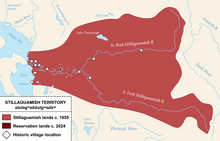stuləgʷabš | |
|---|---|
 Stillaguamish territory in 1855 and 2023 | |
| Total population | |
| 237[1] | |
| Regions with significant populations | |
| Washington, United States | |
| Languages | |
| Lushootseed, English | |
| Religion | |
| Traditional tribal religion and Christianity, incl. syncretic forms | |
| Related ethnic groups | |
| other Lushootseed-speaking peoples |
The Stillaguamish people (still-uh-GWAH-mish; Lushootseed: stuləgʷabš)[2][3] are a Southern Coast Salish[4] people Indigenous to the Stillaguamish River valley in northwestern Washington State in the United States, near the city of Arlington, Washington.[5] The Stillaguamish speak Northern Lushootseed, a Coast Salish language. Although usage of the language has declined, there are ongoing revitalization efforts by the Stillaguamish Tribe.
The Stillaguamish emerged after the end of the last glacial maximum, settling what is now the Stillaguamish River valley after the ice melted. For thousands of years, the Stillaguamish have lived along the Stillaguamish River. The modern Stillaguamish nation descends from the aboriginal Stillaguamish peoples who signed the Treaty of Point Elliot in 1855 as the Stoluck-wa-mish River Tribe. Although they were promised a reservation in the treaty, they were not given one, so while some Stillaguamish moved to Tulalip, the majority of Stillaguamish remained in their traditional territory. In 1976, the Stillaguamish Tribe of Indians was granted federal recognition, with a reservation being created in 2014. Today, most Stillaguamish people are enrolled in the Stillaguamish Tribe, while others are enrolled in the Tulalip Tribes.[2]
- ^ "Stillaguamish Tribe." Northwest Portland Area Indian Health Board. Retrieved September 16, 2013.
- ^ a b "About Us". Stillaguamish Tribe. Retrieved January 23, 2022.
- ^ Bates, Dawn; Hess, Thom; Hilbert, Vi (1994). Lushootseed Dictionary. Seattle: University of Washington Press. ISBN 978-0-295-97323-4.
- ^ Suttles, Wayne; Lane, Barbara (1990). Southern Coast Salish. Handbook of North American Indians. Vol. 7. Smithsonian Institution. pp. 485–502.
- ^ Pritzker, Barry M. (2000). A Native American Encyclopedia: History, Culture, and Peoples. Oxford University Press. p. 197. ISBN 978-0-19-513877-1.